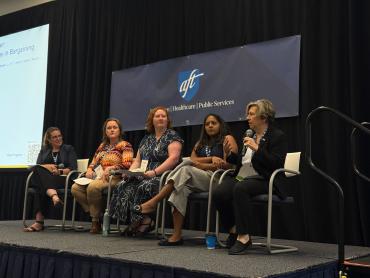Five collective bargaining veterans distilled the basics of building and using leverage during a packed session July 23 in Washington, D.C., at the AFT Collective Bargaining Conference.
Guided by moderator Stephanie Ly, AFT deputy senior director, the panel featured AFT President Randi Weingarten alongside three leaders who navigated challenging circumstances to negotiate first contracts during the past year: Dr. Jahnavi Chandrashekar of Northwest Medicine United in Oregon, Regina McGinnis of the United Health Professionals of New Mexico and Emily VanDerhoff of the Fairfax County Federation of Teachers in Virginia.
Find your influencers first
Weingarten opened by stressing that leverage begins with careful mapping. Titles don’t always signal power, she said; influence may be found with a respected physician, a mid‑level budget analyst or a community pastor rather than a CEO or a president. Knowing who actually “has juice”—inside the workplace and across the neighborhood—lets bargaining teams develop the right relationships and apply pressure in the right places instead of “shouting at the wrong door.”
Chandrashekar recounted how it was the presence of a 50‑member physician unit striking alongside 5,000 out‑of‑contract nurses that caught the Providence hospital system’s attention. After executing Oregon’s largest healthcare walkout ever, the final contract included caps on workload, salary increases and job‑security language that is now being referenced at other Providence sites.
Build coalitions with communities, colleagues and competitors
The Oregon campaign stretched over a year, but Vanderhoff’s fight in Fairfax County unfolded at lightning speed. After Virginia lifted its decades‑long ban on public sector bargaining in 2021, educators had to persuade the school board to opt in, collect authorization cards and negotiate before the county’s budget deadline—a matter of two months. The educators merged with the National Education Association chapter to create one bargaining unit, and parents weighed in en masse, giving the unions leverage to win higher salaries and paid parental leave.
Let the community speak for itself—and lean on friends in high places
McGinnis described a smaller arena—a 62‑bed hospital outside Albuquerque that, despite its size, still suffered from unsafe staffing levels. When nurses organized, management responded with surveillance and terminations. Workers staged street‑corner taco‑truck rallies, posted union‑pride photos and partnered with local teachers for a book drive that linked hospital staffing to children’s well‑being. The tipping point came at a town hall forum where patients testified and New Mexico’s lieutenant governor endorsed the nurses’ demands. Community pressure, combined with a boost from the governor’s office, yielded an agreement that restored benefits and created safe, enforceable nurse‑to‑patient ratios.
Lessons learned
Weingarten also cautioned leaders to treat each collaboration as a relationship, not a transaction. Coalitions can fray, so organizers should leave doors open and maintain positive channels of communication.
The panel concluded by noting that successfully building and applying leverage is rarely achieved through a single dramatic action. Instead, it results from a sequence of tasks: identifying influence, building coalitions, escalating pressure when necessary, and negotiating methodically.
[Melanie Boyer]

